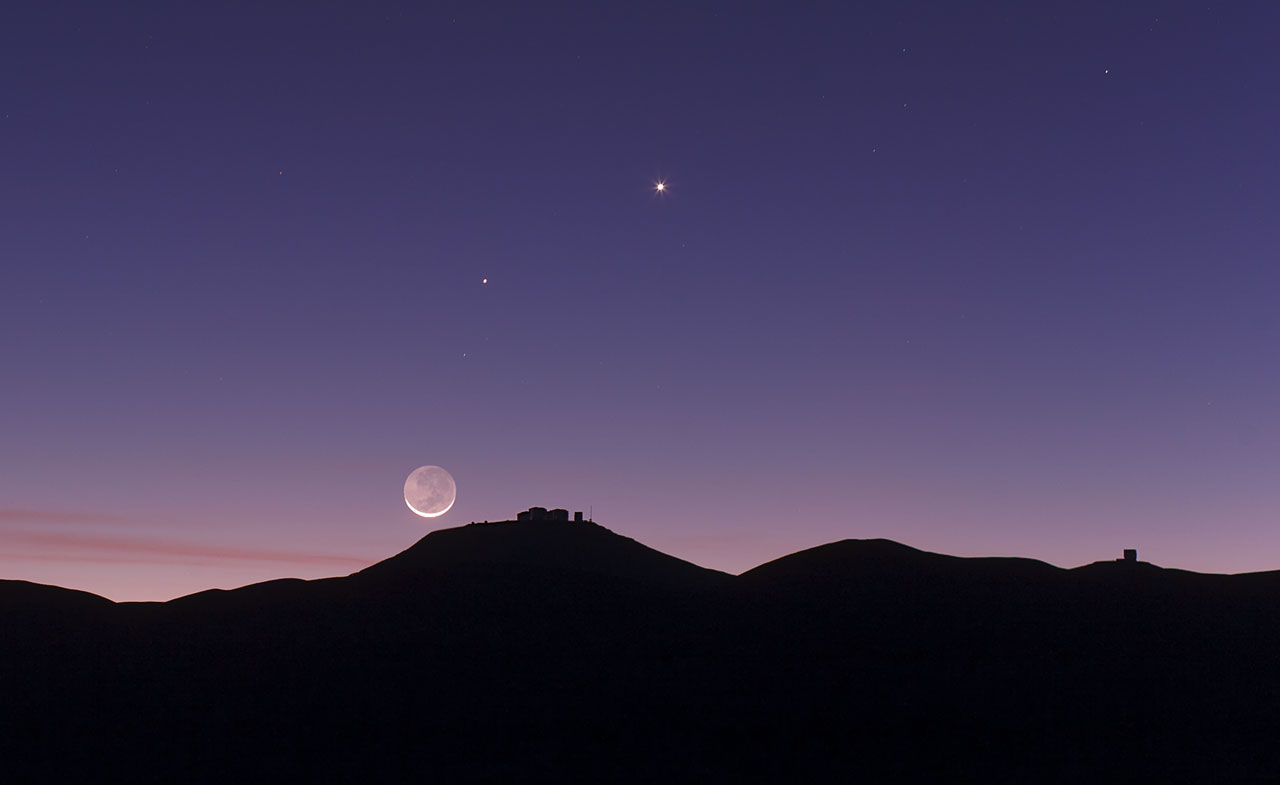European Southern Observatory | 2012 Feb 29
By observing the Moon using ESO’s Very Large Telescope, astronomers have found evidence of life in the Universe — on Earth. Finding life on our home planet may sound like a trivial observation, but the novel approach of an international team may lead to future discoveries of life elsewhere in the Universe. The work is described in a paper to appear in the 1 March 2012 issue of the journal Nature.
“We used a trick called earthshine observation to look at the Earth as if it were an exoplanet,” says Michael Sterzik (ESO), lead author of the paper. “The Sun shines on the Earth and this light is reflected back to the surface of the Moon. The lunar surface acts as a giant mirror and reflects the Earth’s light back to us — and this is what we have observed with the VLT.”
The astronomers analyse the faint earthshine light to look for indicators, such as certain combinations of gases in the Earth’s atmosphere, that are the telltale signs of organic life. This method establishes the Earth as a benchmark for the future search for life on planets beyond our Solar System.
The fingerprints of life, or biosignatures, are hard to find with conventional methods, but the team has pioneered a new approach that is more sensitive. Rather than just looking at how bright the reflected light is in different colours, they also look at the polarisation of the light, an approach called spectropolarimetry. By applying this technique to earthshine observed with the VLT, the biosignatures in the reflected light from Earth show up very strongly.
Co-author of the study Stefano Bagnulo (Armagh Observatory, Northern Ireland, United Kingdom) explains the advantages: "The light from a distant exoplanet is overwhelmed by the glare of the host star, so it’s very difficult to analyse — a bit like trying to study a grain of dust beside a powerful light bulb. But the light reflected by a planet is polarised, while the light from the host star is not. So polarimetric techniques help us to pick out the faint reflected light of an exoplanet from the dazzling starlight."
The team studied both the colour and the degree of polarisation of light from the Earth after reflection from the Moon, as if the light was coming from an exoplanet. They managed to deduce that the Earth’s atmosphere is partly cloudy, that part of its surface is covered by oceans and — crucially — that there is vegetation present. They could even detect changes in the cloud cover and amount of vegetation at different times as different parts of the Earth reflected light towards the Moon.
“Finding life outside the Solar System depends on two things: whether this life exists in the first place, and having the technical capability to detect it,” adds co-author Enric Palle (Instituto de Astrofisica de Canarias, Tenerife, Spain). “This work is an important step towards reaching that capability.”
"Spectropolarimetry may ultimately tell us if simple plant life — based on photosynthetic processes — has emerged elsewhere in the Universe," concludes Sterzik. “But we are certainly not looking for little green men or evidence of intelligent life.”
The next generation of telescopes, such as the E-ELT (the European Extremely Large Telescope), may well be able to bring us the extraordinary news that the Earth is not alone as a bearer of life in the vastness of space.
Biosignatures as revealed by spectropolarimetry of Earthshine - Michael F. Sterzik, Stefano Bagnulo, Enric Palle
- Nature 483(7387) 64 (01 Mar 2012) DOI: 10.1038/nature10778 (eso pdf)
ScienceShot: Clues From the Dark Side of the Moon
Science NOW | Ken Croswell | 2012 Feb 29
Earthshine holds clues to exoplanet aliens
New Scientist | 2012 Feb 29
Life in the Universe, Reflected by the Moon
Universe Today | Nancy Atkinson | 2012 Feb 29
Earth Sheds Light on Alien Worlds
Discovery News | Irene Klotz | 2012 Feb 29
'Earth-like' Planets May Be Nothing Like Earth
Discovery News | Ray Villard | 2012 Feb 29
Finding Life Through Polarized Light
Centauri Dreams | Paul Gilster | 2012 Mar 01
